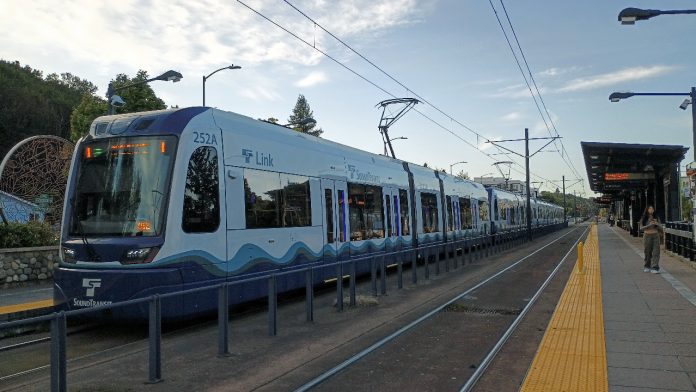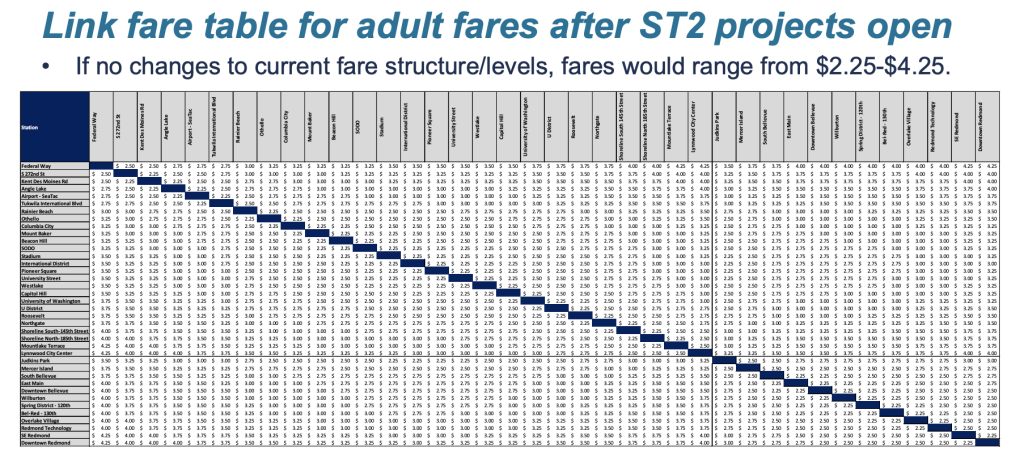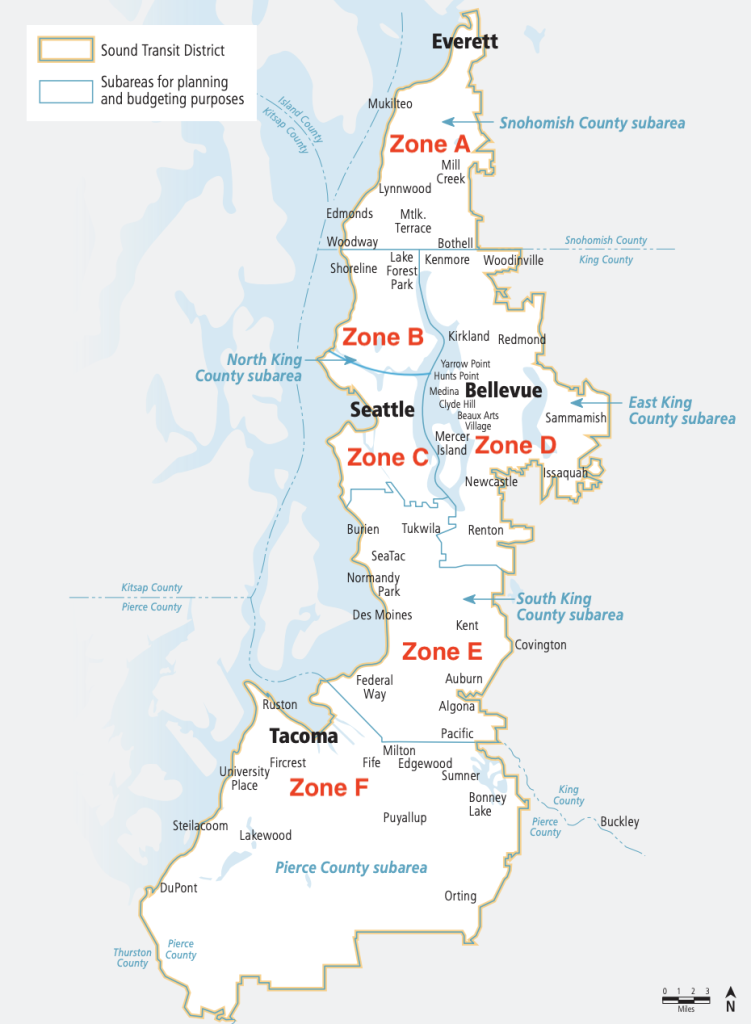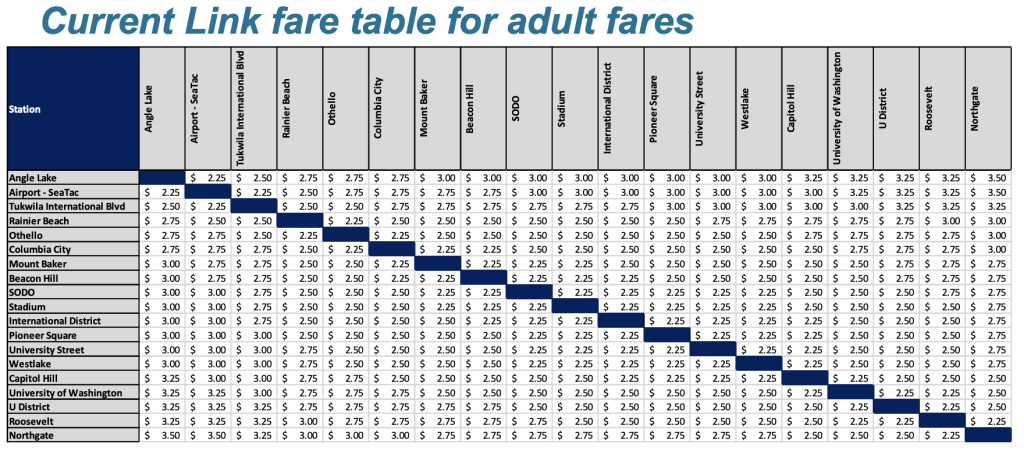
Fares on Link are poised to increase, but Sound Transit is evaluating two different fare structures. The agency should be considering a third.
Sound Transit is moving forward with alternative changes to Link fares in response to light rail expansions on the horizon and the fact that agency policy ordinarily would have required a fare increase by now to maintain the 40% farebox recovery target. The agency is considering two very different fare structure approaches, either as flat fares or distance-based fares. Zone-based fares, however, are not under consideration but could be a valuable alternative for most riders.
Regardless of which fare structure Sound Transit chooses, the agency will maintain reduced fare categories for people who are disabled, seniors, or low-income. Youth riders will also continue to ride free.
All scenarios assume some effective fare increase to partially keep up with inflation and reach a particular farebox ratio target, but agency staff have indicated that the days of 40% farebox recovery are gone. Sound Transit boardmembers will eventually have to decide what the ultimate target will be as part of the fare change process. What the farebox recovery target is set at will be important because it will drive future fare hike discussions as well.
Status quo distance-based fares
Currently, Sound Transit uses a distance-based fare structure on Link. Regular adult riders are charged a base fare of $2.25 but because the fare is also distanced-based, an additional $0.05 is charged per mile rounded up or down to the nearest $0.25. Thus, a one-mile ride is still $2.25 whereas a six-mile ride is $2.50.
As a consequence of the Link system set to grow substantially in the next few years, riders will be able to travel further than ever on light rail. That complicates matters because the distance-based fare matrix will become more complex and top fare prices could grow by more than a dollar. Sticking with the current distance-based fare system could become quite unwieldy for riders to understand and pricier than flat fares for riders going the longest distances.
Under the scenario of retaining distance-based fares, Sound Transit is planning to increase the base fare by $0.25 or $0.50 for a regular adult — that’s still to be determined. That would translate to a fare structure ranging from $2.50 to $4.50 or $2.75 to $4.75 once the Lynnwood, Redmond, and Federal Way Link extensions open. These rates could wind up being higher than comparable tram and bus service. Regular adult fares cost $2.25 on Seattle Streetcar, $2.75 on King County Metro buses, and $3.25 on ST Express buses. But unlike Link, those services all use flat fare structures.

Another pitfall of distance-based fares is that they can be hefty for riders who forget to tap off. Since fares are charged by distance, riders using ORCA cards must tap on and off to receive the lowest fare for a trip. Riders who forget to tap off at the end of a journey are charged the maximum.
A benefit of distance-based fares, however, is that riders who aren’t traveling across most of the Link system would pay lower fares than under a flat fare system.
Flat fares: A hit to Seattle and short trips
And that brings us to flat fares. Sound Transit is evaluating a standard adult Link fare that would be either $3.00, $3.25, or $3.50. Those rates could be modestly higher than a distance-based fare system, particularly for the bulk of riders in Seattle. In other words, flat fares would generally be a subsidy benefiting transit riders outside of Seattle.
While Sound Transit has cited social equity to argue for flat fares, staff have also admitted tradeoffs are mixed with the proposal; typical low-income riders in the Rainier Valley would suffer a net loss, while typical low income riders in the South Sound would see a net benefit based on the agency’s analysis.
The main benefit of flat fares is that riders wouldn’t have to tap off. The agency has also said it might be easier to institute fare-capping with a flat fare structure, but that could still be done with a distanced-based fare structure, albeit with more complexity on the backend of the ORCA system.
Zoned-based fares offer better alternative
Something that Sound Transit is not considering is zone-based fares. But many mature transit agencies across the globe use them in rail transit, such as systems in Vancouver, London, and Zurich. A zone-based system offers a balanced approach that could be more equitable than flat fares but also more simplistic than distanced-based fares. Sound Transit did have a form of zone-based fares several years ago with ST Express.

A zone-based fare system could essentially mimic the Sound Transit taxing district subareas, except with two zones in the North King County Subarea. Riders traveling within one zone or two zones could be charged the lowest fare. Riders traveling within more than two zones would pay incrementally higher fares.
In terms of fares, the following table offers a potential fare structure for this zone-based system:
| Zones | A | B | C | D | E | F |
| A | $2.75 | $2.75 | $3.50 | $4.75 | $4.75 | $6.75 |
| B | $2.75 | $2.75 | $2.75 | $3.50 | $3.50 | $4.75 |
| C | $3.50 | $2.75 | $2.75 | $2.75 | $2.75 | $3.50 |
| D | $4.75 | $3.50 | $2.75 | $2.75 | $3.50 | $4.75 |
| E | $4.75 | $3.50 | $2.75 | $3.50 | $2.75 | $2.75 |
| F | $6.75 | $4.75 | $3.50 | $4.75 | $2.75 | $2.75 |
This structure would favor short- and medium-distance trips over longer ones, by keeping fares lower for most trip pairs and charging higher fares for the longest trips. This approach offers a more regionally equitable structure while keeping fare matrices relatively simple. This type of simple fare structure could also fit relatively neatly into fare-capping.
While Sound Transit is not considering zone-based fares, the agency is running an online open house through October 22. Riders can provide feedback on the distance-based and flat fare alternatives as well as comments asking for consideration of a more regionally equitable zone-based system.
Stephen is a professional urban planner in Puget Sound with a passion for sustainable, livable, and diverse cities. He is especially interested in how policies, regulations, and programs can promote positive outcomes for communities. With stints in great cities like Bellingham and Cork, Stephen currently lives in Seattle. He primarily covers land use and transportation issues and has been with The Urbanist since 2014.


